Resourcing Talent Report: Recruitment, Selection, and Induction
VerifiedAdded on 2022/12/28
|8
|2000
|1
Report
AI Summary
This report provides a comprehensive overview of resourcing talent within organizations, focusing on recruitment and selection processes. It begins by highlighting the benefits of a diverse workforce and the factors influencing talent planning and recruitment policies. The report then delves into various recruitment methods, including internal and external strategies, and selection methods such as ability tests and interviews. It also covers the creation of job descriptions and person specifications, along with the use of recruitment channels like online job boards and social media. The report further discusses selection criteria, interview techniques, and record-keeping practices, including the retention of pre-employment and post-hiring documents. Additionally, it explores the purpose and significance of employee induction, outlining key areas to be covered. The report concludes by emphasizing the importance of effective recruitment and selection in attracting talented candidates and contributing to organizational success. References to relevant books and journals are included to support the findings.
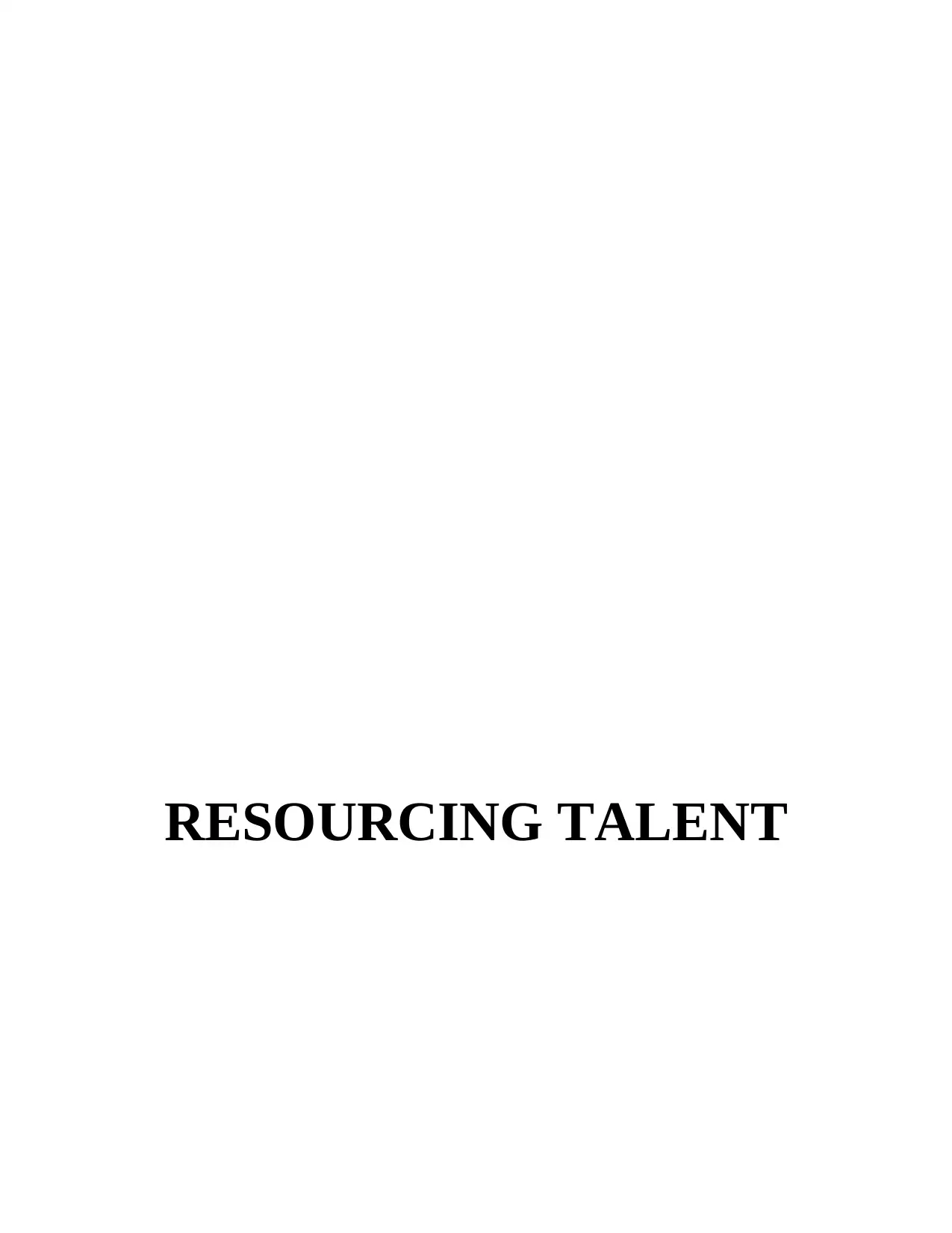
RESOURCING TALENT
Paraphrase This Document
Need a fresh take? Get an instant paraphrase of this document with our AI Paraphraser
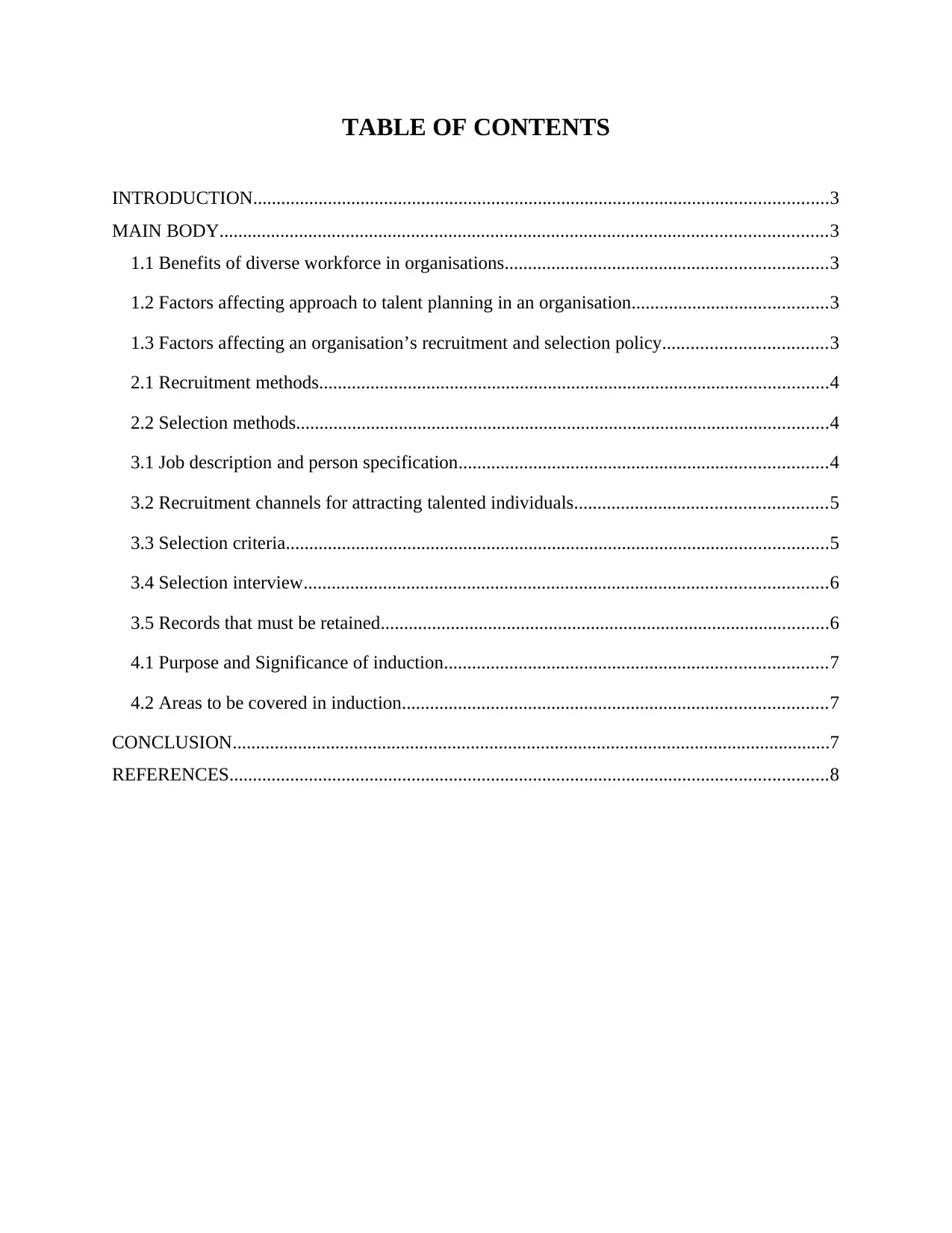
TABLE OF CONTENTS
INTRODUCTION...........................................................................................................................3
MAIN BODY..................................................................................................................................3
1.1 Benefits of diverse workforce in organisations.....................................................................3
1.2 Factors affecting approach to talent planning in an organisation..........................................3
1.3 Factors affecting an organisation’s recruitment and selection policy...................................3
2.1 Recruitment methods.............................................................................................................4
2.2 Selection methods..................................................................................................................4
3.1 Job description and person specification...............................................................................4
3.2 Recruitment channels for attracting talented individuals......................................................5
3.3 Selection criteria....................................................................................................................5
3.4 Selection interview................................................................................................................6
3.5 Records that must be retained................................................................................................6
4.1 Purpose and Significance of induction..................................................................................7
4.2 Areas to be covered in induction...........................................................................................7
CONCLUSION................................................................................................................................7
REFERENCES................................................................................................................................8
INTRODUCTION...........................................................................................................................3
MAIN BODY..................................................................................................................................3
1.1 Benefits of diverse workforce in organisations.....................................................................3
1.2 Factors affecting approach to talent planning in an organisation..........................................3
1.3 Factors affecting an organisation’s recruitment and selection policy...................................3
2.1 Recruitment methods.............................................................................................................4
2.2 Selection methods..................................................................................................................4
3.1 Job description and person specification...............................................................................4
3.2 Recruitment channels for attracting talented individuals......................................................5
3.3 Selection criteria....................................................................................................................5
3.4 Selection interview................................................................................................................6
3.5 Records that must be retained................................................................................................6
4.1 Purpose and Significance of induction..................................................................................7
4.2 Areas to be covered in induction...........................................................................................7
CONCLUSION................................................................................................................................7
REFERENCES................................................................................................................................8
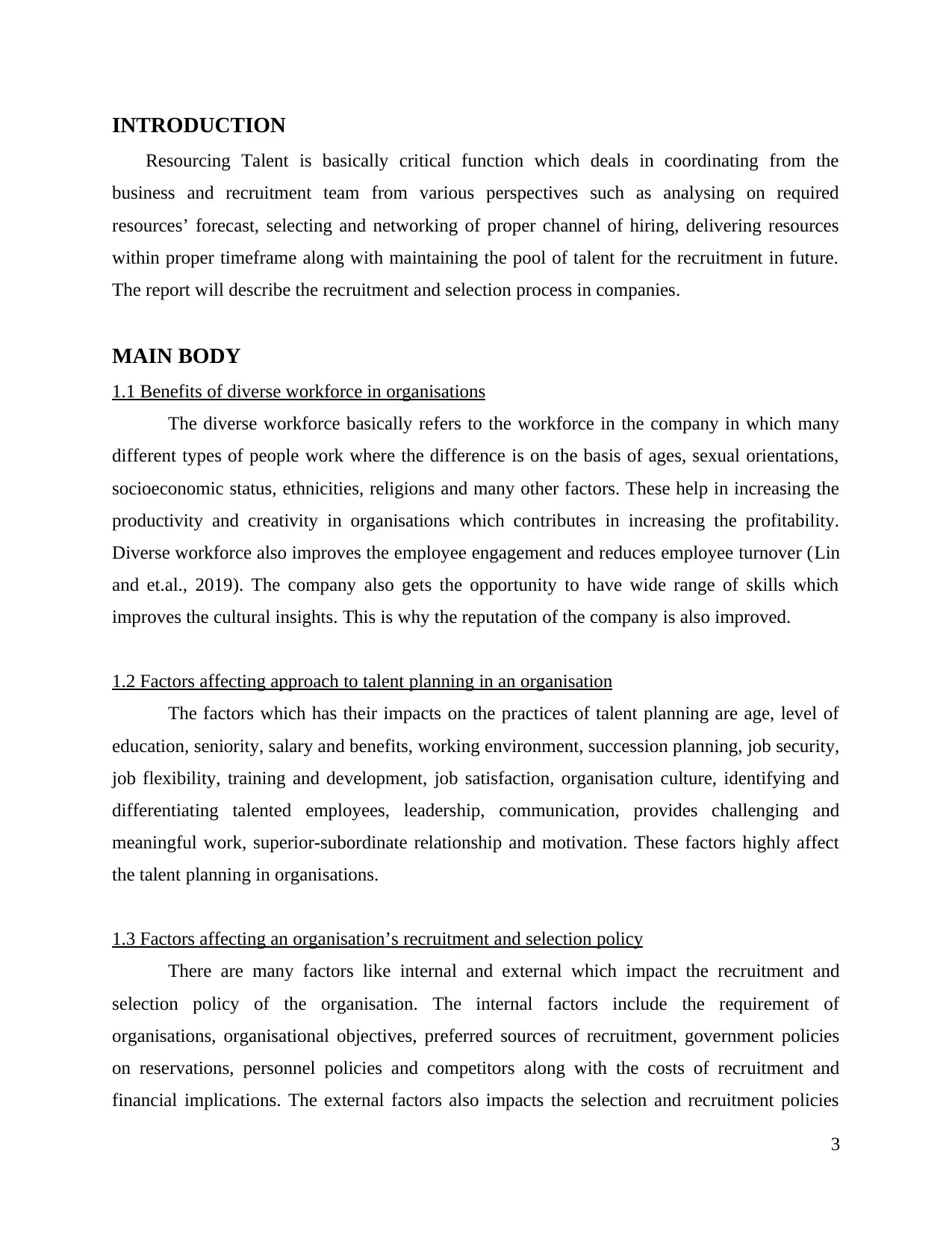
INTRODUCTION
Resourcing Talent is basically critical function which deals in coordinating from the
business and recruitment team from various perspectives such as analysing on required
resources’ forecast, selecting and networking of proper channel of hiring, delivering resources
within proper timeframe along with maintaining the pool of talent for the recruitment in future.
The report will describe the recruitment and selection process in companies.
MAIN BODY
1.1 Benefits of diverse workforce in organisations
The diverse workforce basically refers to the workforce in the company in which many
different types of people work where the difference is on the basis of ages, sexual orientations,
socioeconomic status, ethnicities, religions and many other factors. These help in increasing the
productivity and creativity in organisations which contributes in increasing the profitability.
Diverse workforce also improves the employee engagement and reduces employee turnover (Lin
and et.al., 2019). The company also gets the opportunity to have wide range of skills which
improves the cultural insights. This is why the reputation of the company is also improved.
1.2 Factors affecting approach to talent planning in an organisation
The factors which has their impacts on the practices of talent planning are age, level of
education, seniority, salary and benefits, working environment, succession planning, job security,
job flexibility, training and development, job satisfaction, organisation culture, identifying and
differentiating talented employees, leadership, communication, provides challenging and
meaningful work, superior-subordinate relationship and motivation. These factors highly affect
the talent planning in organisations.
1.3 Factors affecting an organisation’s recruitment and selection policy
There are many factors like internal and external which impact the recruitment and
selection policy of the organisation. The internal factors include the requirement of
organisations, organisational objectives, preferred sources of recruitment, government policies
on reservations, personnel policies and competitors along with the costs of recruitment and
financial implications. The external factors also impacts the selection and recruitment policies
3
Resourcing Talent is basically critical function which deals in coordinating from the
business and recruitment team from various perspectives such as analysing on required
resources’ forecast, selecting and networking of proper channel of hiring, delivering resources
within proper timeframe along with maintaining the pool of talent for the recruitment in future.
The report will describe the recruitment and selection process in companies.
MAIN BODY
1.1 Benefits of diverse workforce in organisations
The diverse workforce basically refers to the workforce in the company in which many
different types of people work where the difference is on the basis of ages, sexual orientations,
socioeconomic status, ethnicities, religions and many other factors. These help in increasing the
productivity and creativity in organisations which contributes in increasing the profitability.
Diverse workforce also improves the employee engagement and reduces employee turnover (Lin
and et.al., 2019). The company also gets the opportunity to have wide range of skills which
improves the cultural insights. This is why the reputation of the company is also improved.
1.2 Factors affecting approach to talent planning in an organisation
The factors which has their impacts on the practices of talent planning are age, level of
education, seniority, salary and benefits, working environment, succession planning, job security,
job flexibility, training and development, job satisfaction, organisation culture, identifying and
differentiating talented employees, leadership, communication, provides challenging and
meaningful work, superior-subordinate relationship and motivation. These factors highly affect
the talent planning in organisations.
1.3 Factors affecting an organisation’s recruitment and selection policy
There are many factors like internal and external which impact the recruitment and
selection policy of the organisation. The internal factors include the requirement of
organisations, organisational objectives, preferred sources of recruitment, government policies
on reservations, personnel policies and competitors along with the costs of recruitment and
financial implications. The external factors also impacts the selection and recruitment policies
3
⊘ This is a preview!⊘
Do you want full access?
Subscribe today to unlock all pages.

Trusted by 1+ million students worldwide
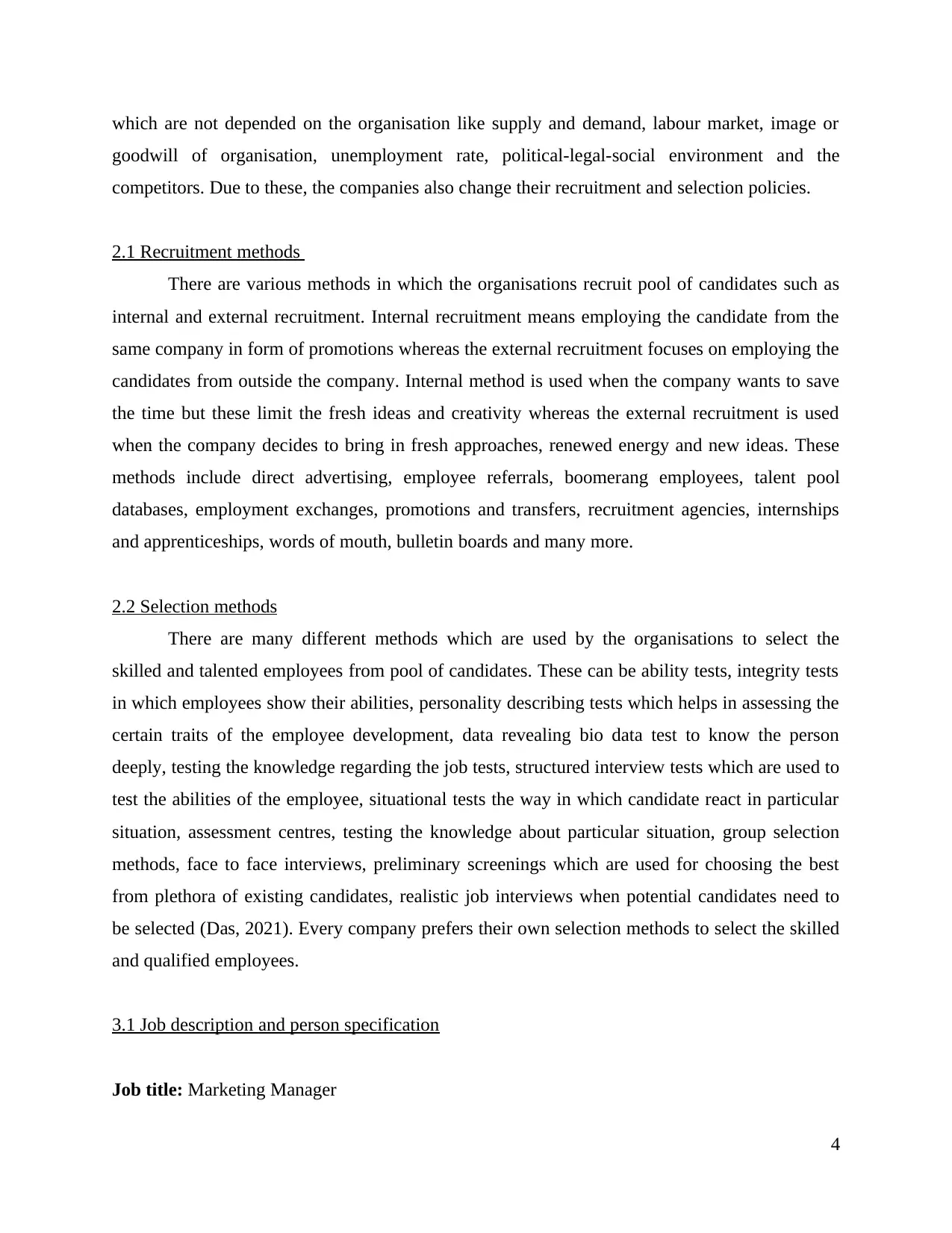
which are not depended on the organisation like supply and demand, labour market, image or
goodwill of organisation, unemployment rate, political-legal-social environment and the
competitors. Due to these, the companies also change their recruitment and selection policies.
2.1 Recruitment methods
There are various methods in which the organisations recruit pool of candidates such as
internal and external recruitment. Internal recruitment means employing the candidate from the
same company in form of promotions whereas the external recruitment focuses on employing the
candidates from outside the company. Internal method is used when the company wants to save
the time but these limit the fresh ideas and creativity whereas the external recruitment is used
when the company decides to bring in fresh approaches, renewed energy and new ideas. These
methods include direct advertising, employee referrals, boomerang employees, talent pool
databases, employment exchanges, promotions and transfers, recruitment agencies, internships
and apprenticeships, words of mouth, bulletin boards and many more.
2.2 Selection methods
There are many different methods which are used by the organisations to select the
skilled and talented employees from pool of candidates. These can be ability tests, integrity tests
in which employees show their abilities, personality describing tests which helps in assessing the
certain traits of the employee development, data revealing bio data test to know the person
deeply, testing the knowledge regarding the job tests, structured interview tests which are used to
test the abilities of the employee, situational tests the way in which candidate react in particular
situation, assessment centres, testing the knowledge about particular situation, group selection
methods, face to face interviews, preliminary screenings which are used for choosing the best
from plethora of existing candidates, realistic job interviews when potential candidates need to
be selected (Das, 2021). Every company prefers their own selection methods to select the skilled
and qualified employees.
3.1 Job description and person specification
Job title: Marketing Manager
4
goodwill of organisation, unemployment rate, political-legal-social environment and the
competitors. Due to these, the companies also change their recruitment and selection policies.
2.1 Recruitment methods
There are various methods in which the organisations recruit pool of candidates such as
internal and external recruitment. Internal recruitment means employing the candidate from the
same company in form of promotions whereas the external recruitment focuses on employing the
candidates from outside the company. Internal method is used when the company wants to save
the time but these limit the fresh ideas and creativity whereas the external recruitment is used
when the company decides to bring in fresh approaches, renewed energy and new ideas. These
methods include direct advertising, employee referrals, boomerang employees, talent pool
databases, employment exchanges, promotions and transfers, recruitment agencies, internships
and apprenticeships, words of mouth, bulletin boards and many more.
2.2 Selection methods
There are many different methods which are used by the organisations to select the
skilled and talented employees from pool of candidates. These can be ability tests, integrity tests
in which employees show their abilities, personality describing tests which helps in assessing the
certain traits of the employee development, data revealing bio data test to know the person
deeply, testing the knowledge regarding the job tests, structured interview tests which are used to
test the abilities of the employee, situational tests the way in which candidate react in particular
situation, assessment centres, testing the knowledge about particular situation, group selection
methods, face to face interviews, preliminary screenings which are used for choosing the best
from plethora of existing candidates, realistic job interviews when potential candidates need to
be selected (Das, 2021). Every company prefers their own selection methods to select the skilled
and qualified employees.
3.1 Job description and person specification
Job title: Marketing Manager
4
Paraphrase This Document
Need a fresh take? Get an instant paraphrase of this document with our AI Paraphraser

Position: 1
Reports to: Commercial Director
Location: England, UK
Job overview: Leading, Developing and executing the targeted media relations, publicity, public
relations and programmes of internal communications for the multinational company.
Qualification: Ordinary degree of SCQF Level 9 or appropriate SVQ4.
Hours of work: 48 hours per week but are flexible.
Duties and responsibilities:
Writing, editing and distributing the press materials and the initiatives for the publicity.
Contact point for media, press and the firm’s spokesperson.
Advising the teams of leadership and the executives on the issues of media and PR.
Managing the agencies of public relations which also include the budgets (Bogatova,
2017).
Writing the newsletter for the internal company.
Managing the training, feedback and guidance of media.
3.2 Recruitment channels for attracting talented individuals
There are various channels of recruitment which are used by most of the organisations.
These include online job boards on which the job advert can be posted, company or the corporate
website, employee referrals, social media and many more. Among all these, the online job boards
are the most common channel of recruitment on which 60% of the total people begin their job
hunt. The big as well as niche boards must be used. For example, the big ones like Monster,
Indeed etc, can be used for attracting the ideal candidates and the niche ones include the GitHub,
Dice etc. (Gardner, 2018). The job advert for HR manager must be appealing by initiating it with
eye-catching title, writing it for the people and appealing it to the emotions for understanding the
feelings of emotions, optimizing it with keywords as HR and selling the position with
highlighting benefits like flexible working, healthcare, casual Fridays etc.
3.3 Selection criteria
The selection criteria for HR manager are that the person must have achieved the
Bachelor’s degree in business management or something equivalent. The person must have
5
Reports to: Commercial Director
Location: England, UK
Job overview: Leading, Developing and executing the targeted media relations, publicity, public
relations and programmes of internal communications for the multinational company.
Qualification: Ordinary degree of SCQF Level 9 or appropriate SVQ4.
Hours of work: 48 hours per week but are flexible.
Duties and responsibilities:
Writing, editing and distributing the press materials and the initiatives for the publicity.
Contact point for media, press and the firm’s spokesperson.
Advising the teams of leadership and the executives on the issues of media and PR.
Managing the agencies of public relations which also include the budgets (Bogatova,
2017).
Writing the newsletter for the internal company.
Managing the training, feedback and guidance of media.
3.2 Recruitment channels for attracting talented individuals
There are various channels of recruitment which are used by most of the organisations.
These include online job boards on which the job advert can be posted, company or the corporate
website, employee referrals, social media and many more. Among all these, the online job boards
are the most common channel of recruitment on which 60% of the total people begin their job
hunt. The big as well as niche boards must be used. For example, the big ones like Monster,
Indeed etc, can be used for attracting the ideal candidates and the niche ones include the GitHub,
Dice etc. (Gardner, 2018). The job advert for HR manager must be appealing by initiating it with
eye-catching title, writing it for the people and appealing it to the emotions for understanding the
feelings of emotions, optimizing it with keywords as HR and selling the position with
highlighting benefits like flexible working, healthcare, casual Fridays etc.
3.3 Selection criteria
The selection criteria for HR manager are that the person must have achieved the
Bachelor’s degree in business management or something equivalent. The person must have
5

minimum experience of 3 years as HR manager in a multinational company. He must have
strong influencing and interpersonal skills, communication skills, problem solving and decision
making skills, excellent planning and organisational skills and also the person willing to be the
HR manager must be result-oriented (Conway and Monks, 2017). The candidates having these
qualifications and skills will be shortlisted and the others will not be eligible for the further
selection processes.
3.4 Selection interview
During the interview for the selection of candidates, various questions are asked from the
candidates and on the basis of the answers the candidates are selected or rejected for the post of
HR manager.
What is the most liked thing working in Human resources?
What is ideal HR workplace for you?
As an HR employee, what are your goals for future?
How is HR profession considered by you?
Whom will you follow after becoming the HR manager?
What is the reason behind choosing this company for working as HR manager?
What are the qualities in you which can make you the best HR manager?
The decision taken by the interviewer will be based on the answers given by the candidates.
3.5 Records that must be retained
All the documents of pre-employment must be retained for almost 3 years followed by
the termination. The documents of pre-employment include job descriptions, resumes or
applications, offer letters and the interview evaluations and after the hiring the additional
documents like background check, personal details, contact details, employment details, job
details, payroll records. Training and development along with achievements and awards must be
retained.
Letter of appointment
Dear xyz,
6
strong influencing and interpersonal skills, communication skills, problem solving and decision
making skills, excellent planning and organisational skills and also the person willing to be the
HR manager must be result-oriented (Conway and Monks, 2017). The candidates having these
qualifications and skills will be shortlisted and the others will not be eligible for the further
selection processes.
3.4 Selection interview
During the interview for the selection of candidates, various questions are asked from the
candidates and on the basis of the answers the candidates are selected or rejected for the post of
HR manager.
What is the most liked thing working in Human resources?
What is ideal HR workplace for you?
As an HR employee, what are your goals for future?
How is HR profession considered by you?
Whom will you follow after becoming the HR manager?
What is the reason behind choosing this company for working as HR manager?
What are the qualities in you which can make you the best HR manager?
The decision taken by the interviewer will be based on the answers given by the candidates.
3.5 Records that must be retained
All the documents of pre-employment must be retained for almost 3 years followed by
the termination. The documents of pre-employment include job descriptions, resumes or
applications, offer letters and the interview evaluations and after the hiring the additional
documents like background check, personal details, contact details, employment details, job
details, payroll records. Training and development along with achievements and awards must be
retained.
Letter of appointment
Dear xyz,
6
⊘ This is a preview!⊘
Do you want full access?
Subscribe today to unlock all pages.

Trusted by 1+ million students worldwide
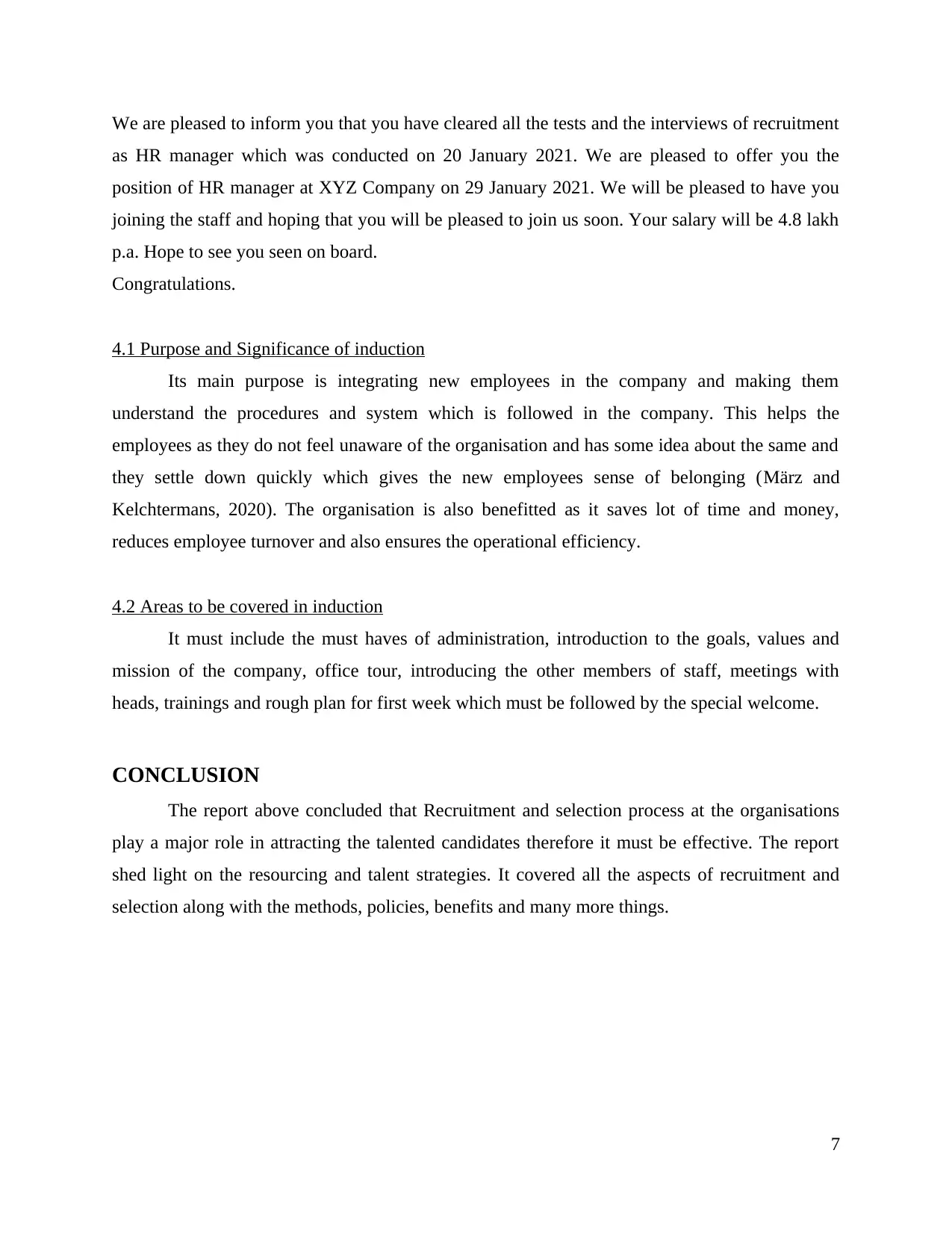
We are pleased to inform you that you have cleared all the tests and the interviews of recruitment
as HR manager which was conducted on 20 January 2021. We are pleased to offer you the
position of HR manager at XYZ Company on 29 January 2021. We will be pleased to have you
joining the staff and hoping that you will be pleased to join us soon. Your salary will be 4.8 lakh
p.a. Hope to see you seen on board.
Congratulations.
4.1 Purpose and Significance of induction
Its main purpose is integrating new employees in the company and making them
understand the procedures and system which is followed in the company. This helps the
employees as they do not feel unaware of the organisation and has some idea about the same and
they settle down quickly which gives the new employees sense of belonging (März and
Kelchtermans, 2020). The organisation is also benefitted as it saves lot of time and money,
reduces employee turnover and also ensures the operational efficiency.
4.2 Areas to be covered in induction
It must include the must haves of administration, introduction to the goals, values and
mission of the company, office tour, introducing the other members of staff, meetings with
heads, trainings and rough plan for first week which must be followed by the special welcome.
CONCLUSION
The report above concluded that Recruitment and selection process at the organisations
play a major role in attracting the talented candidates therefore it must be effective. The report
shed light on the resourcing and talent strategies. It covered all the aspects of recruitment and
selection along with the methods, policies, benefits and many more things.
7
as HR manager which was conducted on 20 January 2021. We are pleased to offer you the
position of HR manager at XYZ Company on 29 January 2021. We will be pleased to have you
joining the staff and hoping that you will be pleased to join us soon. Your salary will be 4.8 lakh
p.a. Hope to see you seen on board.
Congratulations.
4.1 Purpose and Significance of induction
Its main purpose is integrating new employees in the company and making them
understand the procedures and system which is followed in the company. This helps the
employees as they do not feel unaware of the organisation and has some idea about the same and
they settle down quickly which gives the new employees sense of belonging (März and
Kelchtermans, 2020). The organisation is also benefitted as it saves lot of time and money,
reduces employee turnover and also ensures the operational efficiency.
4.2 Areas to be covered in induction
It must include the must haves of administration, introduction to the goals, values and
mission of the company, office tour, introducing the other members of staff, meetings with
heads, trainings and rough plan for first week which must be followed by the special welcome.
CONCLUSION
The report above concluded that Recruitment and selection process at the organisations
play a major role in attracting the talented candidates therefore it must be effective. The report
shed light on the resourcing and talent strategies. It covered all the aspects of recruitment and
selection along with the methods, policies, benefits and many more things.
7
Paraphrase This Document
Need a fresh take? Get an instant paraphrase of this document with our AI Paraphraser
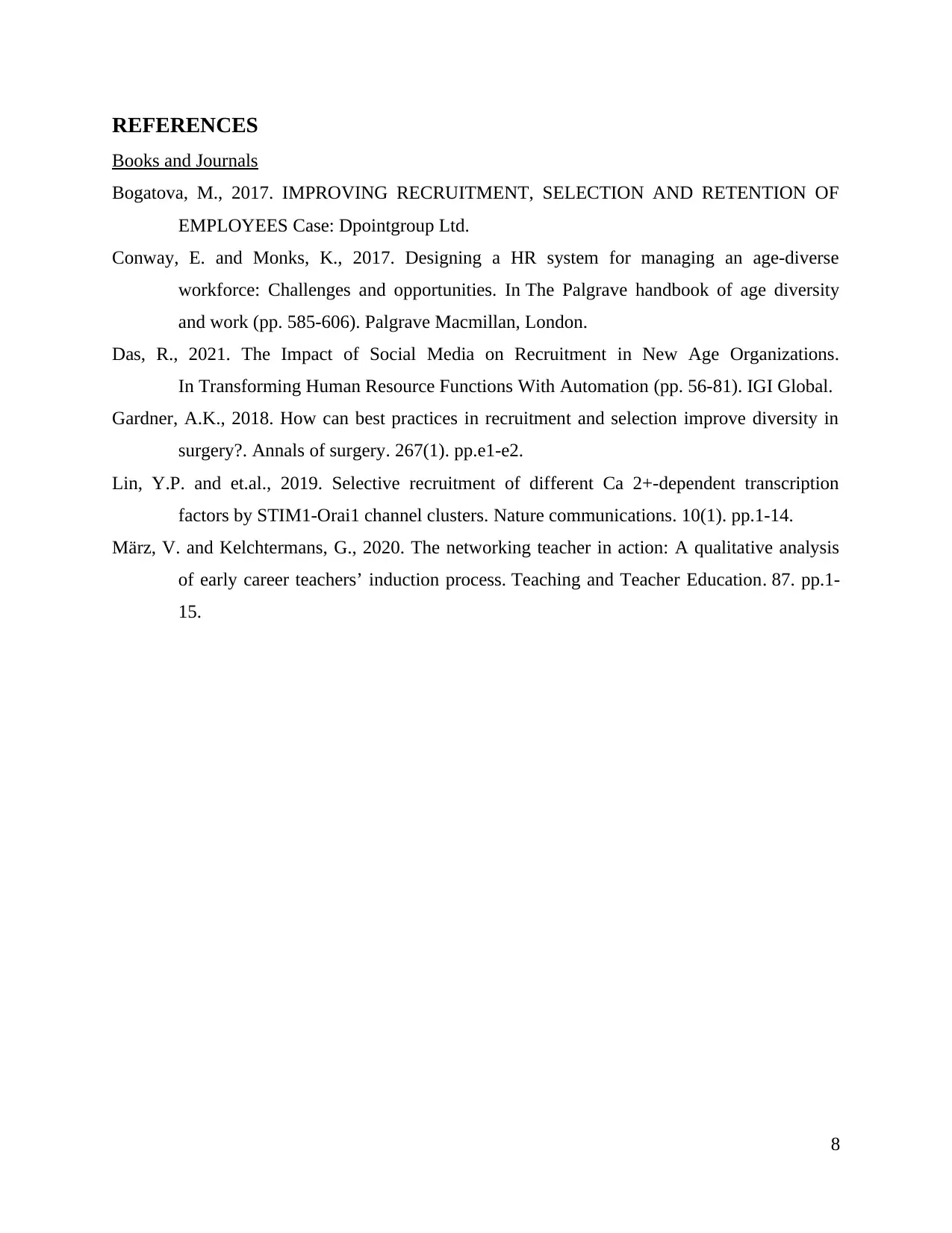
REFERENCES
Books and Journals
Bogatova, M., 2017. IMPROVING RECRUITMENT, SELECTION AND RETENTION OF
EMPLOYEES Case: Dpointgroup Ltd.
Conway, E. and Monks, K., 2017. Designing a HR system for managing an age-diverse
workforce: Challenges and opportunities. In The Palgrave handbook of age diversity
and work (pp. 585-606). Palgrave Macmillan, London.
Das, R., 2021. The Impact of Social Media on Recruitment in New Age Organizations.
In Transforming Human Resource Functions With Automation (pp. 56-81). IGI Global.
Gardner, A.K., 2018. How can best practices in recruitment and selection improve diversity in
surgery?. Annals of surgery. 267(1). pp.e1-e2.
Lin, Y.P. and et.al., 2019. Selective recruitment of different Ca 2+-dependent transcription
factors by STIM1-Orai1 channel clusters. Nature communications. 10(1). pp.1-14.
März, V. and Kelchtermans, G., 2020. The networking teacher in action: A qualitative analysis
of early career teachers’ induction process. Teaching and Teacher Education. 87. pp.1-
15.
8
Books and Journals
Bogatova, M., 2017. IMPROVING RECRUITMENT, SELECTION AND RETENTION OF
EMPLOYEES Case: Dpointgroup Ltd.
Conway, E. and Monks, K., 2017. Designing a HR system for managing an age-diverse
workforce: Challenges and opportunities. In The Palgrave handbook of age diversity
and work (pp. 585-606). Palgrave Macmillan, London.
Das, R., 2021. The Impact of Social Media on Recruitment in New Age Organizations.
In Transforming Human Resource Functions With Automation (pp. 56-81). IGI Global.
Gardner, A.K., 2018. How can best practices in recruitment and selection improve diversity in
surgery?. Annals of surgery. 267(1). pp.e1-e2.
Lin, Y.P. and et.al., 2019. Selective recruitment of different Ca 2+-dependent transcription
factors by STIM1-Orai1 channel clusters. Nature communications. 10(1). pp.1-14.
März, V. and Kelchtermans, G., 2020. The networking teacher in action: A qualitative analysis
of early career teachers’ induction process. Teaching and Teacher Education. 87. pp.1-
15.
8
1 out of 8
Related Documents
Your All-in-One AI-Powered Toolkit for Academic Success.
+13062052269
info@desklib.com
Available 24*7 on WhatsApp / Email
![[object Object]](/_next/static/media/star-bottom.7253800d.svg)
Unlock your academic potential
Copyright © 2020–2025 A2Z Services. All Rights Reserved. Developed and managed by ZUCOL.





